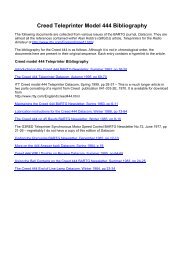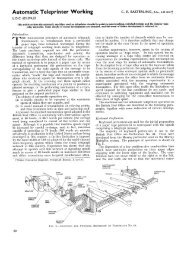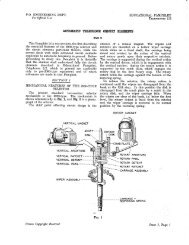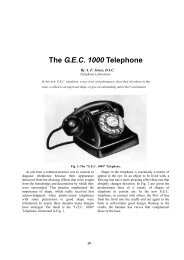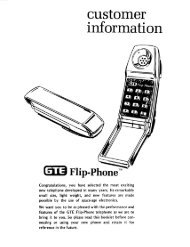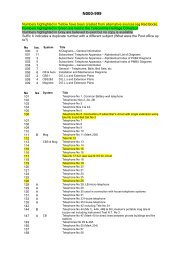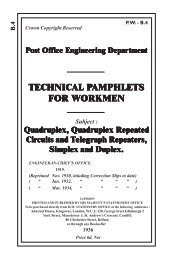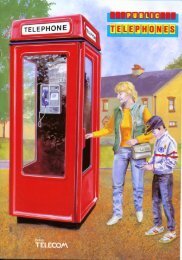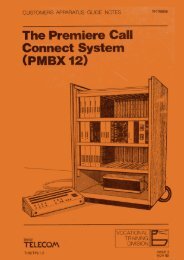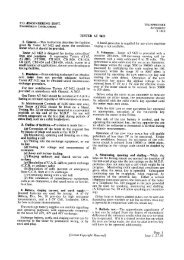TRAFFIC CONTROL TELEPHONE SYSTEMS Circuit - Sam Hallas
TRAFFIC CONTROL TELEPHONE SYSTEMS Circuit - Sam Hallas
TRAFFIC CONTROL TELEPHONE SYSTEMS Circuit - Sam Hallas
You also want an ePaper? Increase the reach of your titles
YUMPU automatically turns print PDFs into web optimized ePapers that Google loves.
Page 8<br />
Common Parts<br />
One 4304-A Selector.<br />
(For the 4001-A or the 4002-A Selector Sets.)<br />
Three Dry Cells.<br />
One No. 4110-A Protector.<br />
Alternative patterns of telephone sets and the method of ordering any piece of<br />
apparatus will be found in our Catalogue "Railway Systems (Apparatus)" D/TD17DI.<br />
NOTE.-Way stations equipped with the 4305-B instead of the 4304-A Selector (see<br />
under Common Parts above) will require from one to three extension bells and<br />
additional telephone sets (with dry cells and battery boxes) the quantity depending<br />
upon the number of extension sets connected to the Selector. Additional<br />
No. 4110-A Protectors may also be required.<br />
<strong>Circuit</strong> Description<br />
Figure 1, facing page 8, is a schematic diagram showing the Controller's circuit<br />
together with the two way station circuits. References mentioned in the following<br />
description apply to this figure.<br />
The controller operates the selector key having the same code, which we will<br />
assume is 3-11-3, as that of the selector at the way station he wishes to call.<br />
On the release of the key, contacts K1 and K3 are closed, and remain closed<br />
during the revolution of the code wheel. The closing of these contacts operates the<br />
BR relay via 10 volts positive, B4 terminal, call key contacts (Time Sending Set), K1<br />
to K3 of Selector Key, winding of BR relay to B3 terminal and 10 volts negative. The<br />
operation of BR connects the line battery to line, thus:-line battery positive, B1<br />
terminal, circuit breaker, line battery switch, SR contacts, retard coils, BR contacts,<br />
line switch, line protectors thence to L1 or L3 or both. The circuit to the other line is<br />
made via line battery negative, B2 terminal, line battery switch, SR contacts, retard<br />
coils. BR contacts, line switch, line protectors and L2 or L4 or both.<br />
All the selectors (each with its tuning capacitors in series) at the way stations<br />
are in parallel across the line so that when the line battery is first applied they receive<br />
an impulse which clears them from any code pins on which they may be held, so<br />
preparing them for the reception of the code. When the selector key spring K1 rides<br />
over the first tooth of the code wheel, it makes contact with spring K2 (at this stage<br />
K1, 2, and 3 are all in contact) and operates the SR relay via 10 volts negative, B3<br />
terminal, winding of SR, call key (Time Sending Set), K2 to K1 (Selector Key), Call<br />
Key (Time Sending Set), B4 terminal and 10 volts positive. The operation of SR<br />
reverses the line battery connections to the line, thus reversing the polarity of the line



